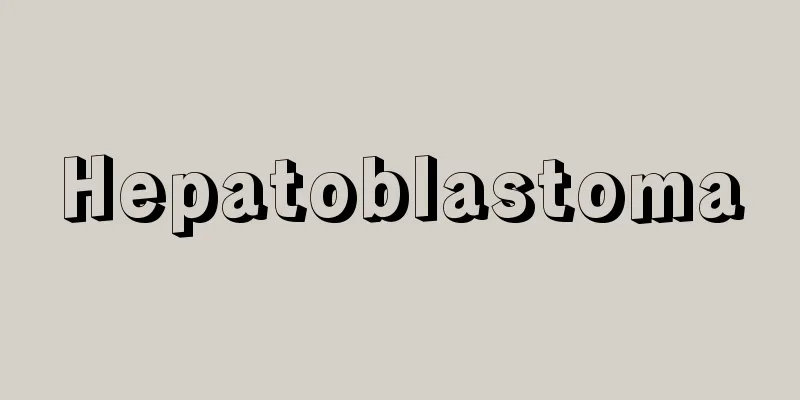Hepatoblastoma

|
It is the most common malignant tumor among children as a primary liver cancer. It accounts for more than 80% of pediatric liver cancers. It occurs most frequently in infancy up to age 3, peaking at age 1. In Japan, it is estimated that there are about 30-40 cases per year, making it a rare tumor that accounts for about 1% of all pediatric malignant tumors. There are no characteristic symptoms, but it is often discovered by abdominal distension or palpable abdominal masses, and it may also be discovered as a result of detailed examination triggered by symptoms of abdominal pain, vomiting, or fever. In blood tests, alpha-fetoprotein levels are significantly elevated. It may also metastasize to the lungs, brain, bones, bone marrow, etc. The disease is classified into stages I to IV based on how much tumor-free area remains in the liver, with I, II, and III classified as the standard risk group, IV as the intermediate risk group, and distant metastasis as the high risk group. Treatment is determined according to the risk classification. For example, in the intermediate-risk group, cisplatin and doxorubicin are used in combination as preoperative chemotherapy to shrink the tumor before surgical removal. Adjuvant chemotherapy is performed after surgery. The prognosis for the standard-risk group is good, with a 90% 5-year survival rate. The possibility of recurrence decreases significantly after three years from diagnosis. For the high-risk group, chemotherapy including cisplatin is used in combination, and after shrinking the tumor, the primary tumor and extrahepatic lesions are resected. Postoperative chemotherapy and liver transplantation may be considered depending on the extent of resection at surgery, the pathological histological type, and the presence or absence of residual disease. [Kiyotaka Watanabe November 20, 2019] [References] | |Source: Shogakukan Encyclopedia Nipponica About Encyclopedia Nipponica Information | Legend |
|
小児の原発性肝臓がんとしてもっとも頻度の高い悪性腫瘍(しゅよう)。小児の肝臓がん中8割以上を占める。1歳をピークとして3歳までの乳幼児期に好発する。日本では年間30~40例程度の発生数と推定されており、小児の悪性腫瘍のなかでも1%程度のまれな腫瘍である。 特徴的な症状はないが、腹部膨満や腹部腫瘤(しゅりゅう)の触知による発見が多く、腹痛、嘔吐(おうと)や発熱の症状をきっかけに精査した結果、発見されることもある。血液検査ではα(アルファ)フェトプロテインが著明に高値となる。肺、脳、骨、骨髄などに転移することもある。 病期分類は、肝臓内に腫瘍の存在しない区域がどれだけ残存しているかをⅠ~Ⅳに分け、Ⅰ・Ⅱ・Ⅲを標準リスク群、Ⅳを中間リスク群、遠隔転移例を高リスク群として分類している。 治療はリスク分類に応じて行われる。たとえば中間リスク群の場合、術前化学療法としてシスプラチンとドキソルビシンを併用し、腫瘍を縮小させてから外科的に切除する。術後は補助化学療法を行う。標準リスク群の5年生存率は90%と予後良好である。診断から3年が経過すると再発の可能性は大きく減少する。高リスク群に対しては、シスプラチンを含む化学療法の併用が行われ、腫瘍縮小後に原発巣と肝外病変の切除が行われる。手術での切除範囲や病理組織型、残存病変の有無などによって術後化学療法や肝移植が考慮されることもある。 [渡邊清高 2019年11月20日] [参照項目] | |出典 小学館 日本大百科全書(ニッポニカ)日本大百科全書(ニッポニカ)について 情報 | 凡例 |
<<: "Enka Collection" - Kankashu
>>: Informatization project - Kankajigyo
Recommend
Chopsticks - Chopsticks
A grass of the Poaceae family (illustration), also...
The Great Fire of Okemachi - Okecho no Taika
The Great Fire of Edo in 1641 (Kan'ei 18). On ...
Tigranes I (English spelling)
… After about 200 BC, Syria was mostly under the ...
The Dictionary of the English Language
…(3) The authoritative standard is in the form of...
Matajiro Koizumi - Matajiro Koizumi
Born: May 17, 1865, Kanagawa Died September 24, 19...
Salix sieboldiana (English spelling) Salixsieboldiana
…[Tetsuichi Yahara]. … *Some of the terminology t...
isomer
...When two or more chemical species have the sam...
Caprolactam - Caprolactam (English spelling)
A lactam (cyclic amide). It is also called 5-amin...
Johannes Anglicus (English spelling)
…She was mentioned and popularized by 13th-centur...
Enoki family
…The direct work of the deputy governor was done ...
Kordofanian
…Congo-Kordofanian is the largest language group ...
revolution paysanne (English spelling) revolution paysanne
...The period of change seen in England is not se...
Maikov, Vasilii Ivanovich
Born: 1728, Yaroslavl Died June 28, 1778. A Russia...
Face bright - Ganki
Date of birth and death unknown. Chinese painter ...
Attractor - Atorakuta
...Therefore, chaos appears in this vicinity. Als...









